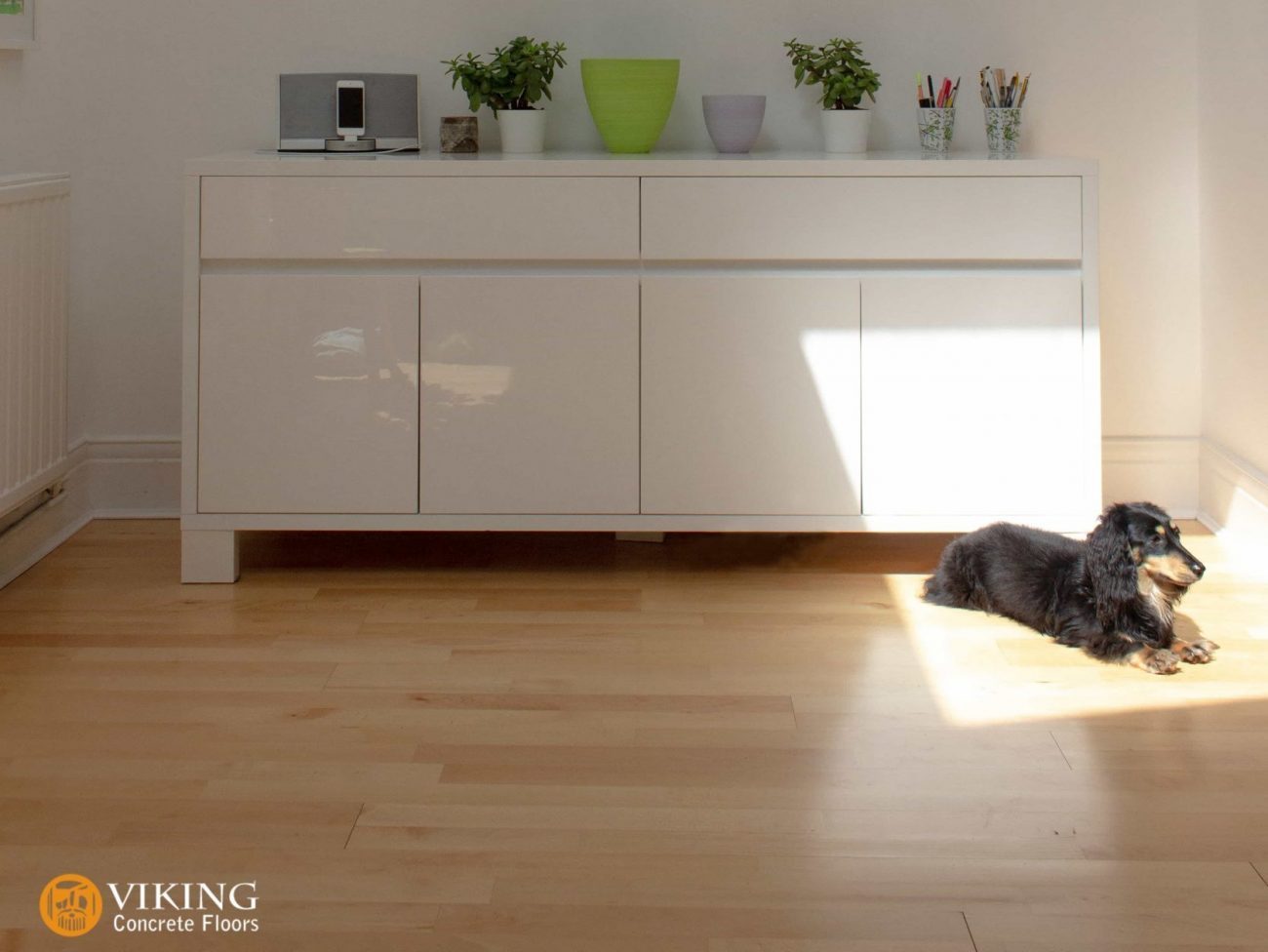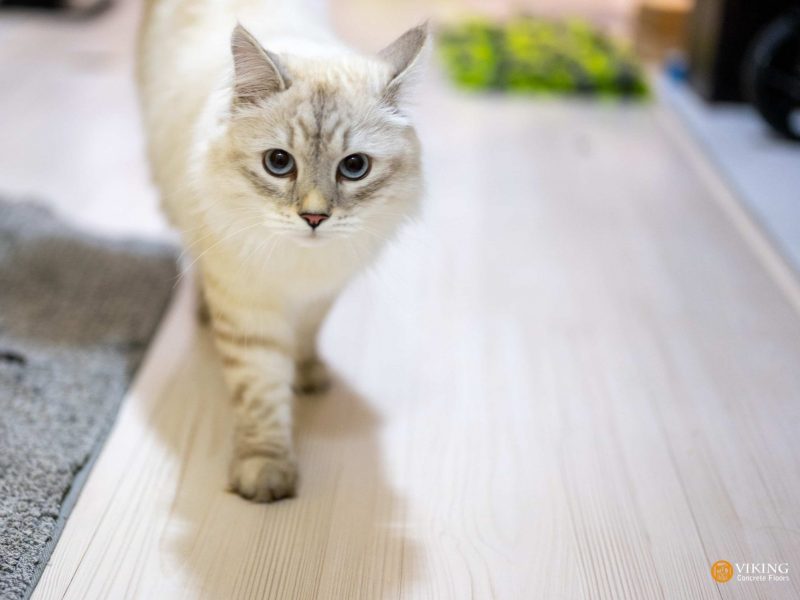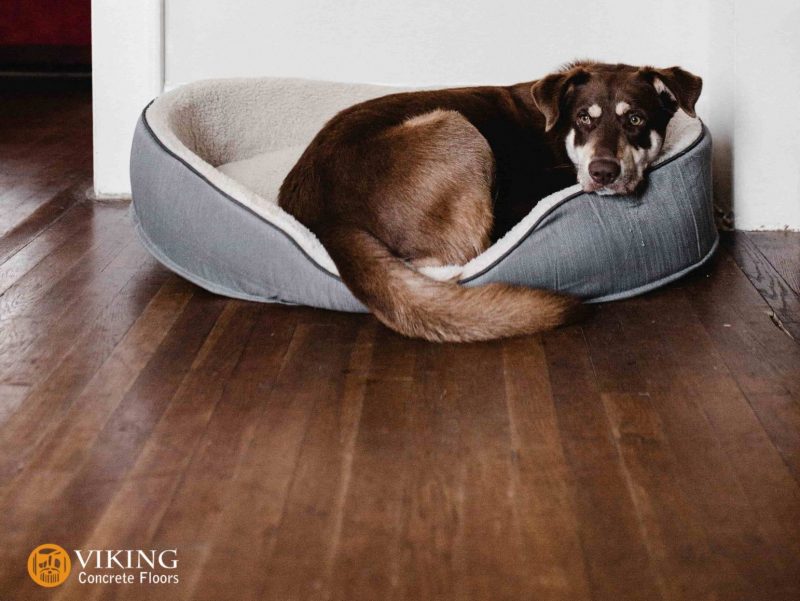
Pet owners face 2 types of flooring problems: damage caused by pets with toenails or claws and staining caused by clumsy accidents that almost every pet has at some point in time. Unless you’re willing to take on a frequent and thorough cleaning and occasional replacement of the entire floor, these factors may rule out some flooring materials. As an example, carpeting is a difficult floor covering for homes with many pets since stains seep in and claws shred the fibers. Under the constant assault of active dogs, top-end hardwood floors are almost certain to be scratched and refinished.
This article will discuss what to look for when choosing flooring for dogs, what type is the most suitable, and what kinds of flooring you should avoid if you have pets at home.
A pet-friendly floor will be one that is entirely moisture and stain-resistant and will have a tough time resisting claw and toenail damage, but such flooring materials may not achieve your design goals. It is even better if your flooring is anti-slip to prevent damage to your pets. When choosing flooring for pets, you should consider design preferences, resistance to pet damage, and your tolerance for replacing or deep-cleaning the materials over time.

What kind of floor will make the pet and owner happy? Here are some features to look for when choosing pet-friendly flooring:
Concrete flooring is sometimes viewed as harsh and industrial, but perceptions are changing, and concrete can be a beautiful flooring option for many homes, especially those with modern decor. Concrete can be polished, textured, stained, or chemically treated in various ways that will produce different visual effects that work well in modern and contemporary living room styles.
The hard surface of the concrete is virtually indestructible against pet stains if it is sealed. Throw rugs and area carpets can also soften the hardness of a living room’s surface. Your pets may damage these pieces, but they are easy to replace or machine wash.
Here are a few of the reasons why concrete flooring is great if you have pets:
Using a protective film-forming sealer or floor finish will prevent pet urine from penetrating concrete pores and leaving behind lingering odors and stains. However, if you have an unsealed concrete floor and urine stains happen, there are several products you can use to remove them.
If you have concrete floors, you don’t have to worry about cleaning up after your pets when they shed fur or run through your house with rain-soaked or muddy feet. Take a broom, towel, or mop and wipe the floor a few times, and the mess is gone.
Pets also shed animal dander (flakes of skin) which can cause allergies especially if you have babies at home. Concrete’s smooth surface won’t trap this dander like other floor types, making it easier to remove during routine cleaning. Additionally, concrete floors will not harbor fleas or mites that your pet may bring into the house.
Various products that accompany carpet installation, such as adhesives and padding, can emit volatile organic compounds or VOCs. Additionally, some adhesives used under vinyl sheet goods and linoleum can emit VOCs. Staining concrete floors with nontoxic pigments does not produce VOCs that harm you and your pets.
Hardwood floors can be scratched up badly by playful, rambunctious pets with their claws. Concrete floors are naturally scratch-resistant, and when sealed with a good floor sealer or floor wax, they are virtually scratchproof.
Many homes tend to be colder at ground level since hot air rises. Because your pets spend most of their time on concrete floors eating, sleeping, and playing, the ability to heat up concrete floors with radiant heat will keep your pets comfortable and reduce your energy bills.
Having mentioned some of the features a pet-friendly flooring should have, now we’ll talk about three-floor types to stay away from when it comes to pet-friendly flooring. Some people may choose one of the three floorings listed below. Although you have the freedom to choose any of them, maintaining them will require extra effort on your part.

Pets can easily scratch and stain carpets, so they are not good for homes with pets. Carpets are highly prone to damage caused by your pets. Cats can scratch on it while dogs can chew on it, especially if it’s too fluffy. In case your pet knocks your coffee cup over every morning, washing off the mess will cost you a lot.
If you have pets, you should avoid hardwood flooring because it is not water-resistant and can be damaged by pet urine and water spills. Furthermore, hardwood floors are not comfortable enough for pets to rest or relax. To create a relaxed environment, you should add fluffy mats.
Pet-parents usually avoid laminate floors due to their one disadvantage-they are extremely slippery. It is common for dogs to slip and fall on these floors, resulting in a dislocated hip (a problem common to most dog breeds).
The sound of soft meows from a kitten or the wagging tail of a dog after a long day is wonderful when you get home. Every pet owner knows how much joy a pet can bring to a home, but let’s be honest – even well-behaved pets can cause damage. That’s why you need to choose pet-friendly flooring.
Here at Viking Concrete Floors, we guarantee you’ll be satisfied. Over the years, you will save time and money with our full-service approach to concrete flooring. Feel free to contact us if you are looking for a concrete flooring company in and near New Orleans and Prairieville, LA. Feel free to fill the form below or Call us now at (225)-313-7950 for a free consultation on pet-friendly flooring!
If this post was helpful to you, please leave us a 5star review. It would help us a lot. Thanks!